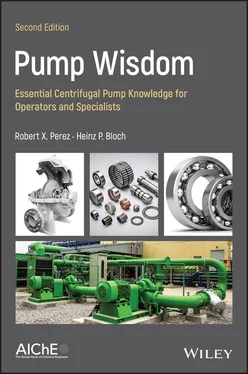1 Cover
2 Title Page
3 Copyright Page
4 Dedication Page
5 Preface
6 1 Principles of Centrifugal Process Pumps Pump Performance: Head and Flow Operation at Zero Flow Impellers and Rotors The Meaning of Specific Speed Process Pump Types Process Pump Mechanical Response to Flow Changes Recirculation and Cavitation The Importance of Suction Specific Speed References
7 2 Pump Selection and Industry Standards Why Insist on Better Pumps ANSI and ISO vs. API Pumps References
8 3 Foundations and Baseplates Securing Pumps in Place – With One Exception Why Not to Install Pump Sets in the As‐Shipped Condition Conventional vs. Prefilled Baseplate Installations Epoxy Prefilled Baseplates How to Proceed If There Is No Access to Specialist Firms References
9 4 Piping, Stationary Seals, and GasketingPipe Installation and Support Sliding Supports and Installation Sequence Deserve Special Attention Monitoring Pipe Stress While Bolting Up Flange Leakage What to Do Prior to Gasket Insertion Spiral Wound and Kammprofile Gaskets Pipe, Hydraulic Tubing or Flexible Connections? Gusseting Concentric vs. Eccentric Reducers Vibration Problems in Piping Proven Ways to Control Piping Vibration Addressing Piping Vibration Issues Small Bore Piping Issues References
10 5 Rolling Element Bearings Bearing Selection Overview and Windage As a Design Problem Radial vs. Axial (Thrust) Bearings Oil Levels, Multiple Bearings and Different Bearing Orientations Upgrading and Retrofit Opportunities Bearing Cages Bearing Preload and Clearance Effects Bearing Dimensions and Mounting Tolerances References
11 6 Lubricant Application and Cooling Considerations Lubricant Level and Oil Application Issues with Oil Rings Pressure and Temperature Balance in Bearing Housings Cooling Not Needed on Pumps with Rolling Element Bearings Oil Delivery by Constant Level Lubricators Black Oil Lubricant Application As Oil Mist (Oil Fog) Desiccant Breathers and Expansion Chambers References
12 7 Lubricant Types and Key PropertiesLubricant Viscosities When and Why High Film Strength Synthetic Lubricants Are Used Lubricants for Oil Mist Systems References
13 8 Bearing Housing Protection and Cost Justification Noncontacting Bearing Protector Seals Contacting Bearing Protector Seals How Venting and Housing Pressurization Affect Bearing Protector Seals Cost Justification Overview Advanced Bearing Housing (Bearing Protector Seal) Summary What We Have Learned References
14 9 Mechanical Sealing Options for Long Life Still Using Packing? General Overview of Mechanical Seals All Flush Plans Have Advantages and Disadvantages Always Obtain the Full Picture Seal Chamber Pumping Ring (Circulating Device) Technologies Lessons Apply to Many Services References
15 10 Pump Operation Starting Centrifugal Pumps Surveillance of Pump Operation Optimum Pump Switching Interval Centrifugal Pump Shutdown Addressing Post Start‐up Issues Avoiding Parallel Pump Operating Problems References
16 11 Impeller Modifications and Pump Maintenance Maintenance Essentials Superior Maintenance Requires Upgrading Impeller Upgrading with Inducers Distance from Impeller Tip to Stationary Internal Casing Components Impeller Trimming Impeller Wear Rings Vane Tip Overfiling and Underfiling Carbon Graphite Wear Rings and Bushings References
17 12 Lubrication Management How Bad Is Water Contamination? Avoid Solids Contamination Avoid Questionable Oil Storage and Transfer Practices Periodic Audits References
18 13 Pump Condition Monitoring Vibration and Its Effect on Bearing Life Monitoring Methods Differ Vibration Acceptance Limits Causes of Excessive Vibration Rotor Balancing References
19 14 Drivers, Couplings, and Alignment Driver Selection Coupling Selection and Installation Installation and Removal Alignment and Quality Criteria Consequences of Misalignment Thermal Rise and Predefinition of Growth References
20 15 Fits, Dimensions, and Related Misunderstandings Low Incremental Cost of Better Pumps Pump Pedestals and Bearing Housings Should Not Be Water‐Cooled Summary of Bearing‐Related Issues Constant Level Lubricators Bearing Housing Protector Seals (“Bearing Isolators”) Motor Lubrication Summary Mechanical Seal Issues Hydraulic Issues Impeller Hydraulics Mechanical Improvement or Upgrade Options Process Pump Repair Dimensions References
21 16 Using Failure Statistics and Root Cause Analysis Findings to Guide Reliability Improvement Efforts Mean‐Time‐Between Failures and Repair Cost Calculations Performing Your Own Projected MTBF Calculations Older Pumps vs. Newer Pumps Reliability Reviews Start Before Purchase Structured Failure Analysis Strategies Solve Problems The “FRETT” Approach to Eradicating Repeat Failures of Pumps Analyzing Pump Failure Data Why We Use Reliability Tools Cumulative Failure Trends Addressing Pump “Bad Actors” References
22 17 Repair, Replace, or Modify? Repair or Replace? Repair and Spare Part Philosophies Making the Business Case for Centrifugal Pump Upgrades Payback Time Examples Centrifugal Pump Hydraulic Rerates Rerate Case Study Replacing Existing Pump with an Entirely Different Model Pump References
23 18 Centrifugal Pump Monitoring Strategies Pump Monitoring Recommendations Based on Criticality How to Use This Matrix A Survey of Vibration Sensors Wireless Sensors Wired Sensors with Dynamic Outputs Wired Loop‐Powered Vibration Transmitters with 4–20 mA Outputs Evaluating Sensor Information Vibration Monitoring Analysis Requirements More on Sensor Technology References
24 19 Final Thoughts
25 Index
26 End User License Agreement
1 Chapter 4 Table 4.1 Nine prominent causes of flange leakage, listed alphabetically. Table 4.2 Defect causes and remedies. Table 4.3 Cause and effect tabulation.
2 Chapter 5Table 5.1 Supplementary designations (suffixes) for SKF double‐row angular c...
3 Chapter 10Table 10.1 Pump affinity laws.
4 Chapter 11Table 11.1 Recommended radial gaps for process pumps.Table 11.2 Physical properties of carbon graphite and graphite material gra...
5 Chapter 13Table 13.1 Allowable field‐installed vibration values for pumps.Table 13.2 Sources of specific vibration excitations.Table 13.3 Maximum diametral hub looseness.
6 Chapter 16Table 16.1 Pump mean‐times‐between‐failures [1].Table 16.2 Suggested refinery seal target MTBFs [1].Table 16.3 Component life targets [1].Table 16.4 How selective component upgrading influences MTBF.Table 16.5 A hypothetical table of pump failures across a processing facili...Table 16.6 A forced ranking of pump failures in the Cat Cracking unit.Table 16.7 Roles and responsibilities matrix for bad actor team.
7 Chapter 17Table 17.1 Likelihood project will be approved, based on the payback period...Table 17.2 Combined failure of history of both pumps.Table 17.3 Performance comparison of the original and rerated pumps.Table 17.4 Pump replacement economics.
8 Chapter 18Table 18.1 Pump monitoring strategies.Table 18.2 Pump monitoring recommendations based on criticality.Table 18.3 Pump monitoring recommendations based on criticality.Table 18.4 Some examples of how spectral alarm bands can be used to detect ...Table 18.5 General spectral analysis guidelines for pump and motor assembli...
1 Chapter 1 Figure 1.1 Principal components of an elementary process pump. Figure 1.2 Typical process pump with suction flow entering horizontally and ... Figure 1.3 A semiopen impeller with five vanes. As shown, the impeller is co... Figure 1.4 Typical “ H – Q ” performance curves are sloped as shown here. The be... Figure 1.5 General flow classifications of process pump impellers. Figure 1.6 Pump specific speed nomogram allowing quick estimations. Shown in... Figure 1.7 Double‐flow impellers are used for higher flows and relatively eq... Figure 1.8 A multistage centrifugal process pump. Figure 1.9 Direction and magnitude of fluid forces change at different flows... Figure 1.10 Where and why impeller vanes get damaged. Figure 1.11 Pump manufacturers usually plot only the NPSHr trend associated ...
Читать дальше









